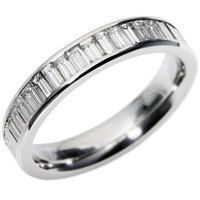
Chemical symbol (Gold): Au
Atomic number: 79
Why choose a white gold wedding ring? White gold is one of our best-sellers, particularly for diamond-set rings - the beautiful white color is often considered to provide a better backdrop for diamonds than yellow gold. White gold was first used in jewelry in the 1920s, closely following the popularity - and rarity - of the similarly colored platinum.

What is in your white gold bands? As gold is normally yellow, the white sheen is achieved by alloying the gold with another metal such as nickel, palladium, platinum or silver; and then plating the ring with rhodium. The more gold that is contained in the alloy, the more yellow the 'white' gold will appear in color, meaning that 18ct white gold is naturally more yellow than 10ct. This is why white gold rings are traditionally plated with rhodium - to get the whitest possible finish. Rhodium also helps protects the ring from wear and tear – if silver is used in an alloy, it could become tarnished by the air, and rhodium is more resistant.
What does your white gold contain? 18ct white gold from Kodega contains 75% gold. The rest is primarily palladium and a little silver. The exact proportions can vary depending on which supplier we use.
Our 10ct white gold contains 41.7% gold, with the rest of the alloy containing mostly silver and perhaps a little nickel. Some people have concerns about allergic reactions from nickel in jewelry but, in the case of white gold, the rhodium plating will help prevent this from happening. Anyhow, the proportions used are extremely low. All of our jewelry containing nickel will have passed the nickel release test. Click here for more information on jewelry and allergies.